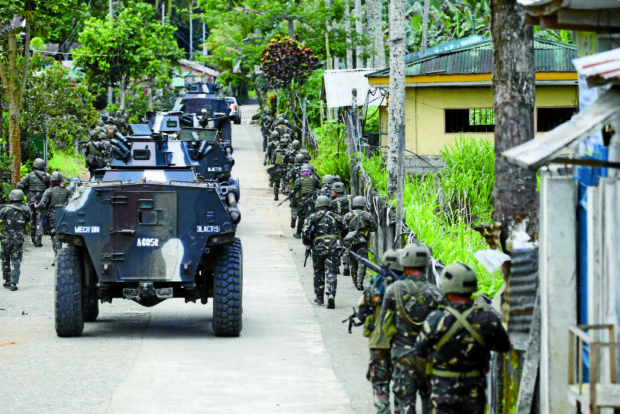
AP
MARAWI CITY—Government troops on Thursday advanced toward the center of Marawi, in an operation aimed at dislodging local terrorists who had seized the city to establish an enclave in the Philippines of the Islamic State (IS) jihadist group in Iraq and Syria.
Lt. Col. Jo-Ar Herrera, spokesperson for the military’s 1st Infantry Division, said government forces had gained control of key bridges in the city after street-to-street fighting in recent days.
He said the security forces were now advancing toward the inner parts of the city where about 150-200 gunmen from the Maute and Abu Sayyaf terrorist groups were holed up in houses and commercial buildings.
Fighting was now confined to 10 percent of the city, or about 8.7 square kilometers, Herrera said.
The battleground constituted four of the city’s 96 barangays, he added.
“We intend to finish the fight as soon as possible,” Herrera told reporters.
The military had stopped using fighter jets and helicopter gunships to avoid injury to civilians trapped in the battle zone, but Herrera said airstrikes could be resumed if the troops on the ground needed air support.
“We have neutralized key enemy positions. [But] our options (airstrikes) are still open,” he said.
About 300-500 civilians are believed to be trapped in houses and buildings in the battle zone and the military, according to Herrera, is doing its best to rescue them.
“We’re still receiving distress calls. The challenge now is [how] long their cell-phone batteries [last]. We’re trying to locate them,” he said.
Herrera said the military was verifying reports about the presence of 300 armed men in a town outside Marawi.
The reports seemed to suggest some of the terrorists had been able to slip out of Marawi and could open a new front.
The crisis began on May 23 when Maute and Abu Sayyaf gunmen rampaged through Marawi after a failed military attempt to capture Isnilon Hapilon, the Abu Sayyaf commander who had pledged allegiance to IS and on whose head the US government had put a $5-million reward.
More than 200 people have died in the fighting, including 58 soldiers and policemen, and 26 civilians.
The military said on Thursday no soldier had been killed since the June 9 gun battle where 13 Marines died.
On the 24th day of the fighting, the government’s losses stood at 58, said Brig. Gen. Restituto Padilla, spokesperson for the Armed Forces of the Philippines.
“It remains at that number. We have not have any soldier killed and, knock on wood, we hope there [will] be no more,” Padilla told reporters.
He said Hapilon, who styles himself as the “emir” of IS in Southeast Asia, was believed to be still in Marawi.
There were reports that the leaders of the Maute group, brothers Omarkhayam and Abdulla Maute, had been killed but Padilla said “we cannot say this is confirmed because we have no evidence yet.”
Evacuees
More than 325,000 people have fled the fighting in Marawi, a city of 200,000 people.
Explaining the discrepancy, Defense Undersecretary Recardo Jalad, executive director of the National Disaster Risk Reduction and Management Council (NDRRMC), said people from areas surrounding Marawi also fled their homes to avoid getting caught in the crossfire.
“And as of [June 15], we have on record 66,738 families composed of 324,406 individuals displaced from Marawi City and the municipality of Marantao in Lanao del Sur,” Jalad said.
“Of this number of displaced people, only about 5 percent are checked in or living, staying inside evacuation centers,” he added.
Jalad said the government had set up 79 evacuation centers in Lanao del Norte, Lanao del Sur and in Cagayan de Oro City.
“Only about 5 percent are currently staying in the evacuation centers. The rest, the 95 percent, are staying in their relatives, in the houses of their relatives and friends, and we call them home-based IDPs (internally displaced people),” he said.
Jalad said the Department of Social Welfare and Development (DSWD) was in charge of managing the evacuation centers, providing for the food and nonfood needs of the evacuees.
The displaced will get P5,000 in financial assistance—P1,000 food allowance and P4,000 for transportation and other needs.
On the other hand, the Department of Health (DOH) was tasked with providing water, health services and sanitation.
Presidential spokesperson Ernesto Abella said that as of June 13 the DSWD central office had sent P60,055,000 to its field offices in Central Visayas, Northern Mindanao, Soccsksargen and Caraga.
It also provided P70,701,994 to its response centers and field offices responding to the fighting in Marawi, Abella said.
“The distribution of relief items is [going on] for the basic needs in the evacuation centers as well as for the needs of home-based IDPs,” Jalad said.
He added that the government is planning to set aside an initial P10 billion for the rebuilding of Marawi after the fighting ends.
“But the exact figure will be determined once we conduct the study, the assessment and then formulate the rehab plan,” Jalad said.
Denied entry into Marawi
Two left-leaning party-list representatives reported on Thursday that they were denied entry into Marawi on a humanitarian mission.
Bayan Muna Rep. Carlos Isagani Zarate and Gabriela Rep. Arlene Brosas, along with former Bayan Muna Rep. Teddy Casiño, were among those who were barred from entering the city as part of the “National Interfaith Humanitarian Mission.”
The delegates were supposed to conduct relief operations and psychosocial services for traumatized residents when they were stopped from entering, according to Bayan Muna.
In a statement, Brosas said Gabriela had coordinated with the military about its plan to distribute relief goods in Marawi but was denied entry when the group got there.
She said the group was forced to bring the relief goods to another destination, an evacuation center in Saguiaran, Lanao del Sur province, where at least 400 families were staying. —WITH REPORTS FROM NIKKO DIZON, PHILIP C. TUBEZA AND DJ YAP